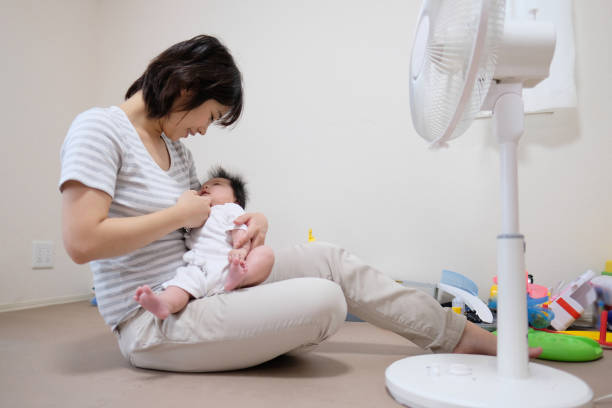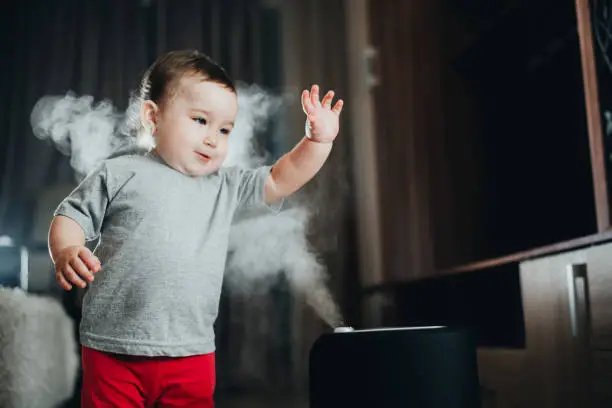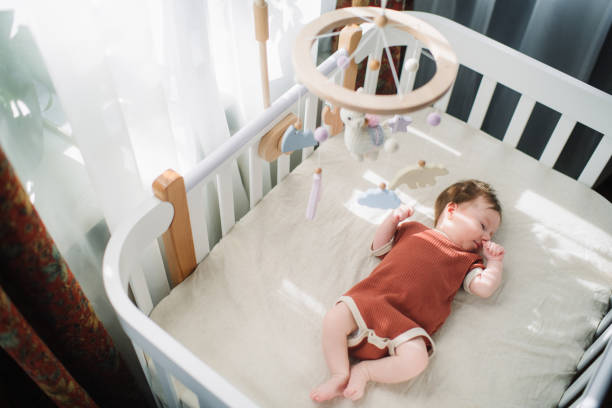Directing a fan at a baby can have detrimental effects on their health and well-being. While fans can provide some distraction and fascination for babies, constant exposure to the airflow can cause rapid body heat loss, leading to hypothermia. Additionally, the fan’s noise and movement can disturb baby sleeps and irritate their delicate skin and eyes.
Maintaining a consistent room temperature and dressing babies in breathable layers can help keep them comfortable without the need for a fan. Directing a fan at the wall instead of the baby can also help circulate air without causing harm. It’s crucial to avoid pointing the fan directly at the baby to minimize their exposure to bacteria and other pollutants in the air, which can lead to short-term ailments such as bronchitis and long-term issues like asthma and hayfever.
Parents and caregivers must be aware of the risks associated with directing a fan at a baby and take necessary precautions to ensure their little ones’ safety. This article will delve deeper into the reasons why you shouldn’t direct a fan at a baby and provide alternatives to keep them comfortable and healthy.
- Understanding Babies' Body Temperature
- Risks of Directing a Fan at a Baby
- Appropriate Conditions for Using a Fan
- Alternatives to Keeping Baby Cool
- Safe Sleep Practices for Babies
- Conclusion
- Frequently Asked Questions
- Can a fan cause harm to a baby?
- What is the safest way to use a fan in a baby's room?
- Does fan air have any negative effects on babies?
- How can I keep my baby cool without using a fan?
- What are the risks of having a fan blowing directly on a sleeping baby?
- Are there any alternatives to using a fan to keep a baby cool?
Understanding Babies’ Body Temperature
Babies have a unique way of regulating their own body temperature too, which is different from adults. Their bodies are not as efficient in retaining heat or cooling down, and they rely on external factors to maintain their body temperature. Therefore, it is crucial to keep their environment at a comfortable temperature to prevent overheating or hypothermia.
A baby’s body temperature can fluctuate quickly, and they are more vulnerable to temperature changes than adults. Their body temperature can be affected by several factors, such as their age, weight, and health conditions. For instance, premature babies or babies with a low birth weight have a harder time regulating their body temperature than full-term babies.
To maintain a baby’s body temperature, it is essential to dress them appropriately for the environment. Dressing them in too many layers can cause them to overheat, while dressing them in too few layers can make them feel cold. It is also important to keep their sleeping area at a consistent temperature to prevent sudden changes in body temperature.
Directing a fan at a baby can cause rapid body heat loss, leading to hypothermia. This is because the fan helps constant airflow can cause their body temperature to drop quickly, making it harder for them to regulate their body temperature. Additionally, the fan’s noise can disturb their sleep, which can affect their overall health and development.
In conclusion, understanding how a baby’s body temperature works is crucial in ensuring their comfort and safety. It is essential to maintain your child at a consistent room temperature and dress them in breathable layers to prevent overheating or hypothermia. Avoid directing a fan at a baby, as it can cause rapid body heat loss and disturb their sleep.
Risks of Directing a Fan at a Baby

Directing a fan at a baby may seem like a good idea to keep them cool during hot weather or while sleeping, but it can have harmful effects on their health. Here are some of the risks associated with directing a fan at a baby:
Risk of Cold
Directing a fan at a baby can cause them to become too cold, especially if they are sleeping in a warm room. This can lead to shivering, which can cause the baby to lose body heat and become even colder. In extreme cases, it can lead to hypothermia, a dangerous condition where the child’s body temperature drops too low.
Risk of SIDS
Sudden Infant Death Syndrome (SIDS) is a serious concern for parents of young babies. Research has shown that directing a fan at a sleeping infant can lower the risk of SIDS by up to 72 percent, especially if the infant is sleeping in a warm room or on their stomach. However, it is important to note that there are other factors that contribute to SIDS, such as sleeping on soft surfaces or exposure to cigarette smoke.
Risk of Dust Allergies
Directing a fan at a baby can increase their exposure to dust and other allergens in the air. This can cause respiratory problems, especially if the baby has asthma or other respiratory conditions. Dust can also irritate the baby’s eyes and skin, causing them to become red and itchy.
In conclusion, while directing a fan at a baby may seem like a good idea, it can have harmful effects on their health. It is important to take precautions to keep your baby cool, such as dressing them in light clothing and keeping their room well-ventilated. If you must use a fan, it is best to direct it away from the baby and towards a wall or ceiling.
Appropriate Conditions for Using a Fan

Nursery Setup
When using a fan in a nursery, it is important to ensure that the fan is placed in an appropriate location. The fan should be placed away from the crib, and preferably on a stable surface. This will help prevent the fan from accidentally falling over and causing injury to the baby. Additionally, it is important to make sure that the fan blades are clean and free of dust and debris, as this can cause the fan to circulate dirty air.
Fan Settings
When using a fan in a nursery, it is important to use the appropriate fan settings. The fan should be set to a low speed to prevent the baby from becoming too cold. Additionally, it is important to make sure that the fan is not blowing directly on the baby, as this can cause rapid body heat loss and lead to hypothermia. To keep the baby comfortable, it is recommended to maintain a consistent room temperature and dress the baby in breathable layers.
Fan Type
When selecting a fan for a nursery, it is important to choose the appropriate fan type. Ceiling fans and oscillating fans are both good options, as they can help circulate air throughout the room. However, it is important to make sure that the fan is not too loud, as this can disturb the baby’s sleep. Additionally, it is important to choose a fan with a sturdy base to prevent it from falling over.
Overall, using a fan in a nursery can be a good way to keep the room cool and a comfortable environment for the baby. However, it is important to make sure that the fan is placed in an appropriate location, set to the appropriate speed, and chosen carefully to ensure that it is safe and effective.
Alternatives to Keeping Baby Cool

Dressing Baby Appropriately
One of the easiest ways to keep a baby cool is by dressing them appropriately. During summer days, it is important to dress the baby in light clothing made of cotton. This will allow air to circulate and keep the baby comfortable. It is also important to keep the baby out of direct sunlight and use shades or blackout curtains to reduce the amount of heat entering the room.
Using Air Conditioner
Another alternative to keeping a baby cool is by using an air conditioner. An air conditioner can help reduce humidity and maintain a comfortable climate in the baby’s room. However, it is important to ensure that the air conditioner is not pointed directly at the baby and that the whole room’s temperature is not too cold. It is also important to keep the baby hydrated by offering milk or water regularly.
Maintaining Air Quality
Maintaining air quality is crucial when it comes to keeping a baby cool. Pollen and other pollutants in the air can cause respiratory problems for babies. It is important to keep windows closed during peak pollen season and use air purifiers to reduce the amount of pollutants in the air.
Proper Room Setup
Proper room setup can also help keep a baby cool. Keeping the door open and using a fan to circulate air can help reduce the temperature in the room. However, it is important to ensure that the fan is not pointed directly at the baby. Additionally, keeping blankets and other unnecessary items out of the baby’s room can help maintain a comfortable climate.
Overall, there are many alternative ways to keep a baby cool without having to direct a fan at them. By dressing the baby appropriately, using air conditioners, maintaining air quality, and setting up the room properly, parents can ensure that their baby is comfortable during hot summer days.
Safe Sleep Practices for Babies

Sleep Environment
Creating a safe sleep environment is crucial for a baby’s well-being. For at least the first six months of life, the American Academy of Pediatrics advises that infants sleep in their own crib, bassinet, or play yard in the parents’ room. The sleep surface should be firm, flat, and covered only with a fitted sheet. Never place a baby to sleep on a soft surface, such as a couch, pillow, or waterbed, as it increases the risk of suffocation.
Sleep Attire
Dressing a baby for sleep can be challenging, especially during hot summer months. It is important to avoid overdressing or underdressing the baby. The ideal room temperature for a baby’s sleep is between 68 and 72 degrees Fahrenheit. Dress the baby in light and breathable clothing, such as a onesie or a sleep sack. Avoid using blankets or loose bedding, as they can pose a suffocation hazard.
White Noise and Sleep
White noise can be an effective way to soothe a baby to sleep. It creates a calming and consistent sound that can help drown out other noises and distractions. However, it is important to use white noise safely. The volume should be low and not exceed 50 decibels, which is about the sound level of a quiet conversation. Additionally, never place the white noise machine too close to the baby’s ears.
Soothing Sound and Timers
Soothing sounds, such as lullabies or nature sounds, can also be helpful in promoting a baby’s sleep. However, it is important to use them safely and appropriately. The volume should be low and soothing, and the sound should be played for a limited time. Some sound machines have built-in timers that can automatically turn off after a set period. This can help prevent the baby from becoming too dependent on the sound to fall asleep.
Swaddle and Sweating
Swaddling can be a useful technique to help calm a fussy baby and promote sleep. However, it is important to swaddle safely. The swaddle should be snug but not too tight, and the baby’s face should be uncovered. Additionally, it is important to monitor the baby’s temperature to prevent overheating. If the baby is sweating or feels too warm, remove the swaddle or dress the baby in lighter clothing.
By following these safe sleep practices, parents can help ensure their baby gets a good night’s sleep while reducing the risk of sleep-related accidents and injuries.
Conclusion
In conclusion, it is not advisable to direct a fan at a baby. While fans can improve air circulation in a room, they can also cause discomfort and pose health risks to infants. Directing a fan at a baby can cause rapid body heat loss, leading to hypothermia. Additionally, the constant airflow may irritate their delicate skin and eyes, while fan noise could disturb their sleep.
Furthermore, directing a fan at a baby increases their exposure to bacteria and other pollutants in the air, which can lead to short-term ailments such as bronchitis and possibly long-term issues like asthma and hayfever. Another serious risk factor of having a fan near a baby is the danger of an electric shock.
To keep a baby comfortable, it is important to maintain a consistent room temperature and dress them in breathable layers. When using a fan in a baby’s room, it should be positioned away from the baby and not directed towards them. Using a fan as a source of distraction for a fussy or overwhelmed baby can be a good idea, but parents should always be mindful of the risks and take necessary precautions to ensure their baby’s safety and comfort.
Overall, while fans can be useful in improving air circulation and providing comfort, it is important to consider the potential risks and take appropriate measures to ensure the safety and well-being of infants.
Frequently Asked Questions
Can a fan cause harm to a baby?
Directing a fan at a baby can cause rapid body heat loss, leading to hypothermia. The constant airflow may also irritate their delicate skin and eyes, while fan noise could disturb their sleep. Additionally, having a fan near a baby increases their exposure to bacteria and other pollutants in the air, which can lead to both short-term ailments (such as bronchitis) and possibly long-term issues like asthma and hay fever.
What is the safest way to use a fan in a baby’s room?
If you must use a fan in a baby’s room, it is recommended to place it at a safe distance from the baby’s crib or bed. The fan should be set on a low speed and pointed away from the baby’s health side. You can also place a damp towel or cloth in front of the fan to help cool the air without directly blowing it onto the baby.
Does fan air have any negative effects on babies?
Fan of air flow can take away the moisture from a baby’s eyes and nose area, leading to discomfort and irritation. It can also cause rapid body heat loss, leading to hypothermia.
How can I keep my baby cool without using a fan?
There are several ways to keep a baby cool without using a fan. You can dress your baby in lightweight, breathable clothing, keep the room shaded and cool, and use a cool mist humidifier to add moisture to the air. You can also place a damp towel or cloth on your baby’s forehead or back of the neck to help cool them down.
What are the risks of having a fan blowing directly on a sleeping baby?
Having a fan blowing directly on a sleeping baby can cause rapid body heat loss, leading to hypothermia. It can also increase their exposure to bacteria and other pollutants in the air, which can lead to both short-term ailments (such as bronchitis) and possibly long-term issues like asthma and hay fever. Additionally, the constant airflow may irritate their delicate skin and eyes, while fan noise could disturb their sleep.
Are there any alternatives to using a fan to keep a baby cool?
Yes, there are several alternatives to using a fan to keep a baby cool. You can dress your baby in lightweight, breathable clothing, keep the room shaded and cool, and use a cool mist humidifier to add moisture to the air. You can also place a damp towel or cloth on your baby’s forehead or back of the neck to help cool them down.




